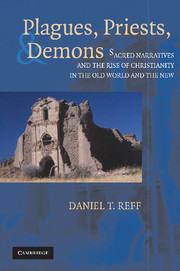 Plagues, Priests, and Demons
Plagues, Priests, and Demons Book contents
- Frontmatter
- Contents
- List of Illustrations
- Acknowledgments
- ONE Introduction
- TWO Disease and the Rise of Christianity in Europe 150–800 c.e.
- THREE Disease and the Rise of Christianity in the New World: The Jesuit Missions of Colonial Mexico
- FOUR The Relevance of Early Christian Literature to Jesuit Missionaries in Colonial Mexico
- Conclusion
- Bibliography
- Index
TWO - Disease and the Rise of Christianity in Europe 150–800 c.e.
Published online by Cambridge University Press: 28 August 2009
- Frontmatter
- Contents
- List of Illustrations
- Acknowledgments
- ONE Introduction
- TWO Disease and the Rise of Christianity in Europe 150–800 c.e.
- THREE Disease and the Rise of Christianity in the New World: The Jesuit Missions of Colonial Mexico
- FOUR The Relevance of Early Christian Literature to Jesuit Missionaries in Colonial Mexico
- Conclusion
- Bibliography
- Index
Summary
Through him [Saint Anthony], the Lord healed many of those present who were suffering in body and freed others from evil spirits.
(Anthanasius's Life of St. Anthony, c. 360 c.e.)A letter from Martin happened to be brought to him and he placed it in her bosom at the very moment when her temperature was rising and at once the fever left her.
(Sulpicius Severus's Life of Saint Martin, c. 396 c.e.)The glorious tomb of the blessed martyr Baudilius is in Nimes … The inhabitants of the region realized that this tomb often possessed a heavenly remedy for many illnesses.
(Gregory of Tours's Glory of the Martyrs, c. 590 c.e.)Early Christian literature abounds in references to sickness and the miraculous cure. Indeed, the miraculous cure is perhaps the most common type scene in sacred biography and history. Why are stories of sick people who are cured by monks and bishops so common, particularly relative to accounts of other “miracles” such as villages saved from marauding enemies or of crops saved from locusts or drought? To date, scholars of late antiquity and the early Middle Ages have shied away from this question. To quote one distinguished historian, “It is usually fruitless to indulge in speculation about what might have been the ‘real’ basis of miracle stories.” Since the Enlightenment, miracles largely have been seen as beyond the bounds of historical analysis. Correspondingly, sacred biography and history, because they are replete with miracles, have been ignored or cast as overly fictitious.
- Type
- Chapter
- Information
- Plagues, Priests, and DemonsSacred Narratives and the Rise of Christianity in the Old World and the New, pp. 35 - 121Publisher: Cambridge University PressPrint publication year: 2004


